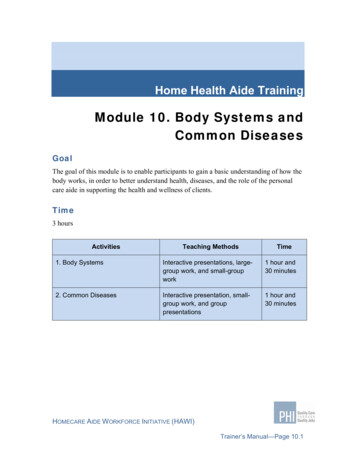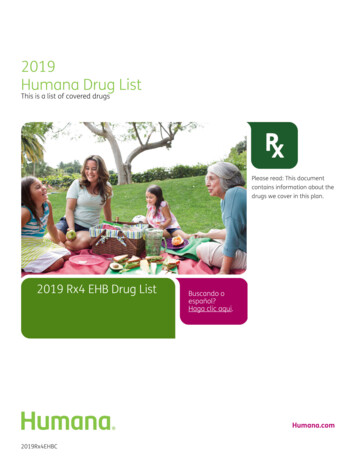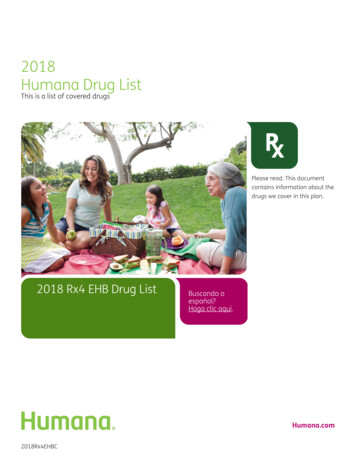
Transcription
LIST OF OCCUPATIONAL DISEASES(revised 2010)Identification and recognition of occupational diseases:Criteria for incorporating diseases in the ILO listof occupational diseases
Occupational Safety and Health Series, No. 74List of occupational diseases(revised 2010)Identification and recognition of occupational diseases:Criteria for incorporating diseases in the ILO listof occupational diseasesINTERNATIONAL LABOUR OFFICE GENEVA
Copyright International Labour Organization 2010First published 2010Publications of the International Labour Office enjoy copyright under Protocol 2 of the Universal CopyrightConvention. Nevertheless, short excerpts from them may be reproduced without authorization, on condition that thesource is indicated. For rights of reproduction or translation, application should be made to ILO Publications (Rightsand Permissions), International Labour Office, CH-1211 Geneva 22, Switzerland, or by email: pubdroit@ ilo.org.The International Labour Office welcomes such applications.Libraries, institutions and other users registered with reproduction rights organizations may make copies inaccordance with the licences issued to them for this purpose. Visit www.ifrro.org to find the reproduction rightsorganization in your country.ILOList of occupational diseases (revised 2010). Identification and recognition of occupational diseases: Criteriafor incorporating diseases in the ILO list of occupational diseasesGeneva, International Labour Office, 2010 (Occupational Safety and Health Series, No. 74)occupational disease / definition. 13.04.3ISBN 978-92-2-123795-2ISSN 0078-3129Also available in French: Liste des maladies professionnelles (révisée en 2010): Identification et reconnaissancedes maladies professionnelles: critères pour incorporer des maladies dans la liste des maladies professionnellesde l’OIT (ISBN 978-92-2-223795-1, ISSN 0250-412x), Geneva, 2010, and in Spanish: Lista de enfermedadesprofesionales (revisada en 2010). Identificación y reconocimiento de las enfermedades profesionales: Criteriospara incluir enfermedades en la lista de enfermedades profesionales de la OIT (ISBN 978-92-2-323795-0,ISSN 0250-4073, Geneva, 2010. ILO Cataloguing in Publication DataThe designations employed in ILO publications, which are in conformity with United Nations practice, and thepresentation of material therein do not imply the expression of any opinion whatsoever on the part of the International Labour Office concerning the legal status of any country, area or territory or of its authorities, orconcerning the delimitation of its frontiers.The responsibility for opinions expressed in signed articles, studies and other contributions rests solely with theirauthors, and publication does not constitute an endorsement by the International Labour Office of the opinionsexpressed in them.Reference to names of firms and commercial products and processes does not imply their endorsement by theInternational Labour Office, and any failure to mention a particular firm, commercial product or process is nota sign of disapproval.ILO publications and electronic products can be obtained through major booksellers or ILO local offices in manycountries, or direct from ILO Publications, International Labour Office, CH-1211 Geneva 22, Switzerland.Catalogues or lists of new publications are available free of charge from the above address, or by email:pubvente@ilo.orgVisit our website: www.ilo.org/publnsPhotocomposed in Switzerland Printed in Switzerland BRIGEN
PrefaceThe International Labour Organization’s Recommendation concerning the Listof Occupational Diseases and the Recording and Notification of Occupational Accidentsand Diseases, 2002 (No. 194), was adopted at the 90th Session of the International LabourConference. The Committee which was established and entrusted by the Conference in2002 to work on Recommendation No. 194 requested the Governing Body of the Inter national Labour Office (ILO) to update the list of occupational diseases annexed to thisRecommendation in accordance with the mechanism stipulated in Paragraph 3 of theRecommendation as a matter of priority.To this end, two Meetings of Experts were organized by the ILO, one in 2005and one in 2009, which established a new list of occupational diseases. This new list wasapproved by the Governing Body at its 307th Session in March 2010. It replaces the oneadopted in 2002 in the Annex to Recommendation No. 194 and can be referred to as the“List of occupational diseases (revised 2010)”. This list of occupational diseases isdesigned to assist countries in the prevention, recording, notification and, if applicable,compensation of diseases caused by work.The new list reflects the state-of-the-art development in the identification andrecognition of occupational diseases. It includes a range of internationally recognizedoccupational diseases, from illnesses caused by chemical, physical and biological agentsto respiratory and skin diseases, musculoskeletal disorders and occupational cancer.Mental and behavioural disorders have been, for the first time, specifically included in theILO list. The list also has open items in all the sections dealing with the aforementioneddiseases. The open items allow for the recognition of the occupational origin of diseasesnot specified in the list if a link is established between exposure to risk factors arising fromwork activities and the disorders contracted by the worker.The Governing Body requested the Office to promote the application of this newlist of occupational diseases and to involve experts appointed by governments, employersand workers in preparation for future updating of the list on the basis of the criteria listedin the “Identification and recognition of occupational diseases: Criteria for incorporatingdiseases in the ILO list of occupational diseases”, a document prepared by the Secretariatto facilitate the work of the 2009 Meeting of Experts. The Governing Body also recommended that the document should be published.This publication is both a response of SafeWork to the recommendations of the2009 Meeting of Experts and part of its efforts to promote the application of the new listof occupational diseases as requested by the Governing Body. It includes the newlyestablished list of occupational diseases, the working document “Identification andrecognition of occupational diseases: Criteria for incorporating diseases in the ILO listof occupational diseases”, and the reports of the two Meetings of Experts which developed this list. v
LIST OF OCCUPATIONAL DISEASES (REVISED 2010)Dr Shengli Niu, Senior Specialist on Occupational Health in SafeWork, carriedout the Office’s technical work on the development of the new list of occupational diseasesand prepared this publication. It is our hope that this publication will enable readers tounderstand the basis on which the list of occupational diseases was updated, as well asfacilitate the application of the 2010 list.Seiji MachidaDirectorProgramme of Safety and Health at Work and the Environment (SafeWork)ILOvi
ContentsPreface. . . . . . . . . . . . . . . . . . . . . . . . . . . . . . . . . . . . . . . . . . . . .vPart I: List of occupational diseases (revised 2010) . . . . . . . . . . . . . . . . . . . . .1Part II: Identification and recognition of occupational diseases:Criteria for incorporating diseases in the ILO list of occupational diseases. . . . . . . .1. Definitions of occupational diseases . . . . . . . . . . . . . . . . . . . . . . . . .2. General criteria for identification and recognition of occupational diseases . . . . .3. Criteria for identification and recognition of an individual disease. . . . . . . . . .4. Criteria for incorporating a disease into the ILO list of occupational diseases . . . .5. Updating the list of occupational diseases. . . . . . . . . . . . . . . . . . . . . . .6. Consultations for the purpose of preparing a common ground. . . . . . . . . . . .7. The common ground achieved through tripartite consultations. . . . . . . . . . . .8. Decision-making process at the Meeting of Expertson the Revision of the List of Occupational Diseases Recommendation,2002 (No. 194) (Geneva, 27–30 October 2009). . . . . . . . . . . . . . . . . . . .77891112131517Annex 1: Report of the Meeting of Experts on Updating the List of OccupationalDiseases, Geneva, 13–20 December 2005. . . . . . . . . . . . . . . . . . . . . . . . . . .19Annex 2: Report of the Meeting of Experts on the Revision of the List of OccupationalDiseases (Recommendation No. 194), Geneva, 27–30 October 2009 . . . . . . . . . . . .53 vii
Part I: List of occupational diseases 1(revised 2010)1.Occupational diseases caused by exposure to agents arising from workactivities1.1.Diseases caused by chemical 5.1.1.16.Diseases caused by beryllium or its compoundsDiseases caused by cadmium or its compoundsDiseases caused by phosphorus or its compoundsDiseases caused by chromium or its compoundsDiseases caused by manganese or its compoundsDiseases caused by arsenic or its compoundsDiseases caused by mercury or its compoundsDiseases caused by lead or its compoundsDiseases caused by fluorine or its compoundsDiseases caused by carbon disulfideDiseases caused by halogen derivatives of aliphatic or aromatic hydrocarbonsDiseases caused by benzene or its homologuesDiseases caused by nitro- and amino-derivatives of benzene or its homologuesDiseases caused by nitroglycerine or other nitric acid estersDiseases caused by alcohols, glycols or ketonesDiseases caused by asphyxiants like carbon monoxide, hydrogen sulfide, hydrogen cyanide or its derivatives1.1.17. Diseases caused by acrylonitrile1.1.18. Diseases caused by oxides of nitrogen1.1.19. Diseases caused by vanadium or its compounds1.1.20. Diseases caused by antimony or its compounds1.1.21. Diseases caused by hexane1.1.22. Diseases caused by mineral acids1.1.23. Diseases caused by pharmaceutical agents1.1.24. Diseases caused by nickel or its compounds1.1.25. Diseases caused by thallium or its compounds1.1.26. Diseases caused by osmium or its compounds1In the application of this list the degree and type of exposure and the work or occupation involvinga particular risk of exposure should be taken into account when appropriate. 1
LIST OF OCCUPATIONAL DISEASES (REVISED 2010)1.1.27. Diseases caused by selenium or its compounds1.1.28. Diseases caused by copper or its compounds1.1.29. Diseases caused by platinum or its compounds1.1.30. Diseases caused by tin or its compounds1.1.31. Diseases caused by zinc or its compounds1.1.32. Diseases caused by phosgene1.1.33. Diseases caused by corneal irritants like benzoquinone1.1.34. Diseases caused by ammonia1.1.35. Diseases caused by isocyanates1.1.36. Diseases caused by pesticides1.1.37. Diseases caused by sulphur oxides1.1.38. Diseases caused by organic solvents1.1.39. Diseases caused by latex or latex-containing products1.1.40. Diseases caused by chlorine1.1.41. Diseases caused by other chemical agents at work not mentioned in the pre cedingitems where a direct link is established scientifically, or determined by methodsappropriate to national conditions and practice, between the exposure to thesechemical agents arising from work activities and the disease(s) contracted by theworker1.2.Diseases caused by physical agents1.2.1.Hearing impairment caused by noise1.2.2.Diseases caused by vibration (disorders of muscles, tendons, bones, joints,peripheral blood vessels or peripheral nerves)1.2.3.Diseases caused by compressed or decompressed air1.2.4.Diseases caused by ionizing radiations1.2.5.Diseases caused by optical (ultraviolet, visible light, infrared) radiations including laser1.2.6.Diseases caused by exposure to extreme temperatures1.2.7.Diseases caused by other physical agents at work not mentioned in the precedingitems where a direct link is established scientifically, or determined by methodsappropriate to national conditions and practice, between the exposure to thesephysical agents arising from work activities and the disease(s) contracted by theworker1.3.Biological agents and infectious or parasitic diseases1.3.1.Brucellosis1.3.2.Hepatitis viruses2
LIST OF OCCUPATIONAL DISEASES1.3.3.Human immunodeficiency virus (HIV)1.3.4.Tetanus1.3.5.Tuberculosis1.3.6.Toxic or inflammatory syndromes associated with bacterial or fungal Diseases caused by other biological agents at work not mentioned in the pre cedingitems where a direct link is established scientifically, or determined by methodsappropriate to national conditions and practice, between the exposure to thesebiological agents arising from work activities and the disease(s) contracted bythe worker2.Occupational diseases by target organ systems2.1.Respiratory diseases2.1.1.Pneumoconioses caused by fibrogenic mineral dust (silicosis, osis2.1.3.Pneumoconioses caused by non-fibrogenic mineral dust2.1.4.Siderosis2.1.5.Bronchopulmonary diseases caused by hard-metal dust2.1.6.Bronchopulmonary diseases caused by dust of cotton (byssinosis), flax, hemp,sisal or sugar cane (bagassosis)2.1.7.Asthma caused by recognized sensitizing agents or irritants inherent to the workprocess2.1.8.Extrinsic allergic alveolitis caused by the inhalation of organic dusts or micro bially contaminated aerosols, arising from work activities2.1.9.Chronic obstructive pulmonary diseases caused by inhalation of coal dust, dustfrom stone quarries, wood dust, dust from cereals and agricultural work, dust inanimal stables, dust from textiles, and paper dust, arising from work activities2.1.10. Diseases of the lung caused by aluminium2.1.11. Upper airways disorders caused by recognized sensitizing agents or irritantsinherent to the work process2.1.12. Other respiratory diseases not mentioned in the preceding items where a directlink is established scientifically, or determined by methods appropriate tonational conditions and practice, between the exposure to risk factors arisingfrom work activities and the disease(s) contracted by the worker2.2.Skin diseases2.2.1.Allergic contact dermatoses and contact urticaria caused by other recognizedallergy-provoking agents arising from work activities not included in other items 3
LIST OF OCCUPATIONAL DISEASES (REVISED 2010)2.2.2.2.2.4.Irritant contact dermatoses caused by other recognized irritant agents arisingfrom work activities not included in other itemsVitiligo caused by other recognized agents arising from work activities notincluded in other itemsOther skin diseases caused by physical, chemical or biological agents at worknot included under other items where a direct link is established scientifically, ordetermined by methods appropriate to national conditions and practice, betweenthe exposure to risk factors arising from work activities and the skin disease(s)contracted by the worker2.3.Musculoskeletal disorders2.3.1.Radial styloid tenosynovitis due to repetitive movements, forceful exertions andextreme postures of the wristChronic tenosynovitis of hand and wrist due to repetitive movements, forcefulexertions and extreme postures of the wristOlecranon bursitis due to prolonged pressure of the elbow regionPrepatellar bursitis due to prolonged stay in kneeling positionEpicondylitis due to repetitive forceful workMeniscus lesions following extended periods of work in a kneeling or squattingpositionCarpal tunnel syndrome due to extended periods of repetitive forceful work, workinvolving vibration, extreme postures of the wrist, or a combination of the threeOther musculoskeletal disorders not mentioned in the preceding items where adirect link is established scientifically, or determined by methods appropriate tonational conditions and practice, between the exposure to risk factors arising fromwork activities and the musculoskeletal disorder(s) contracted by the 3.8.2.4.Mental and behavioural disorders2.4.1.Post-traumatic stress disorder2.4.2.Other mental or behavioural disorders not mentioned in the preceding itemwhere a direct link is established scientifically, or determined by methods appropriate to national conditions and practice, between the exposure to risk factorsarising from work activities and the mental and behavioural disorder(s) contractedby the worker3.Occupational cancer3.1.Cancer caused by the following agents3.1.1.Asbestos3.1.2.Benzidine and its salts3.1.3.Bis-chloromethyl ether (BCME)4
LIST OF OCCUPATIONAL DISEASES3.1.4.Chromium VI compounds3.1.5.Coal tars, coal tar pitches or soots3.1.6.Beta-naphthylamine3.1.7.Vinyl chloride3.1.8.Benzene3.1.9.Toxic nitro- and amino-derivatives of benzene or its homologues3.1.10. Ionizing radiations3.1.11. Tar, pitch, bitumen, mineral oil, anthracene, or the compounds, products or residues of these substances3.1.12. Coke oven emissions3.1.13. Nickel compounds3.1.14. Wood dust3.1.15. Arsenic and its compounds3.1.16. Beryllium and its compounds3.1.17. Cadmium and its compounds3.1.18. Erionite3.1.19. Ethylene oxide3.1.20. Hepatitis B virus (HBV) and hepatitis C virus (HCV)3.1.21. Cancers caused by other agents at work not mentioned in the preceding itemswhere a direct link is established scientifically, or determined by methods appropriate to national conditions and practice, between the exposure to these agentsarising from work activities and the cancer(s) contracted by the worker4.Other diseases4.1.Miners’ nystagmus4.2.Other specific diseases caused by occupations or processes not mentioned in thislist where a direct link is established scientifically, or determined by methodsappropriate to national conditions and practice, between the exposure arisingfrom work activities and the disease(s) contracted by the worker 5
6
Part II: Identification and recognitionof occupational diseases:Criteria for incorporating diseasesin the ILO list of occupational diseases1Definitions of occupational diseasesAccording to the Protocol of 2002 to the Occupational Safety and Health Convention, 1981 (No. 155), the term “occupational disease” covers any disease contracted as aresult of an exposure to risk factors arising from work activity.The ILO Employment Injury Benefits Recommendation, 1964 (No. 121), Paragraph 6(1), defines occupational diseases in the following terms: “Each Member should,under prescribed conditions, regard diseases known to arise out of the exposure tosubstances and dangerous conditions in processes, trades or occupations as occupationaldiseases.”Two main elements are present in the definition of an occupational disease: the causal relationship between exposure in a specific working environment or workactivity and a specific disease; and the fact that the disease occurs among a group of exposed persons with a frequencyabove the average morbidity of the rest of the population. 7
2General criteria for identificationand recognition of occupational diseasesThe causal relationship is established on the basis of clinical and pathologicaldata, occupational background and job analysis, identification and evaluation of occupational risk factors and of the role of other risk factors.Epidemiological and toxicological data are useful for determining the causalrelationship between a specific occupational disease and its corresponding exposure in aspecific working environment or work activity.As a general rule, the symptoms are not sufficiently characteristic to enable anoccupational disease to be diagnosed as such without the knowledge of the pathologicalchanges engendered by the physical, chemical, biological or other factors encountered inthe exercise of an occupation.It is therefore normal that, as a result of improvements in knowledge regardingthe mechanisms of action of the factors in question, the steady increase in the number ofsubstances employed, and the quality and variety of suspected agents, it becomes moreand more feasible to make an accurate diagnosis, while the range of diseases recognizedas occupational in origin is broadening.The recognition of a disease as being occupational is a specific example of clinical decision-making or applied clinical epidemiology. Deciding on the cause of a diseaseis not an “exact science” but rather a question of judgement based on a critical review ofall the available evidence, which should include a consideration of the following: Strength of association. The greater the impact of an exposure on the occurrence ordevelopment of a disease, the stronger the likelihood of a causal relationship. Consistency. Different research reports have generally similar results and conclusions. Specificity. Exposure to a specific risk factor results in a clearly defined pattern ofdisease or diseases. Temporality or time sequence. The exposure of interest preceded the disease by aperiod of time consistent with any proposed biological mechanism. Biological gradient. The greater the level and duration of exposure, the greater theseverity of diseases or their incidence. Biological plausibility. From what is known of toxicology, chemistry, physical properties or other attributes of the studied risk or hazard, it makes biological sense tosuggest that exposure leads to the disease. Coherence. A general synthesis of all the evidence (e.g. human epidemiology andanimal studies) leads to the conclusion that there is a cause–effect relationship in abroad sense and in terms of general common sense. Interventional studies. Sometimes, a primary preventative trial may verify whetherremoving a specific hazard or reducing a specific risk from the working environment orwork activity eliminates the development of a specific disease or reduces its incidence.8
3Criteria for identification and recognitionof an individual diseaseThe exposure–effect relationship (relation between exposure and the severity ofthe impairment in the subject) and the exposure–response relationship (connectionbetween exposure and the relative number of subjects affected) are important elements forthe determination of a causal relationship. Research and epidemiological studies havegreatly contributed in this respect. Better knowledge of the causal relationship has allowedus to achieve a better medical definition of occupational diseases. As a consequence, thelegal definition of occupational diseases, which was rather a complex problem, is becoming more and more linked to the medical definition and criteria.Legal provisions on compensation for victims vary from country to country.Article 8 of the Employment Injury Benefits Convention, 1964 [Schedule I amended in1980] (No. 121), which indicates the various possibilities regarding the form of the identification and recognition of occupational diseases entitling workers to compensationbenefits, states that:Each Member shall:(a) prescribe a list of diseases, comprising at least the diseases enumerated in ScheduleI to this Convention, which shall be regarded as occupational diseases underprescribed conditions; or(b) include in its legislation a general definition of occupational diseases broad enoughto cover at least the diseases enumerated in Schedule I to this Convention; or(c) prescribe a list of diseases in conformity with clause (a), complemented by a generaldefinition of occupational diseases or by other provisions for establishing the occupational origin of diseases not so listed or manifesting themselves under conditionsdifferent from those prescribed.Point (a) is called the “list system”, point (b) is the “general definition system”or overall coverage system, and point (c) is generally referred to as the “mixed system”.The “list system” covers only a certain number of occupational diseases, and hasthe advantage of listing diseases for which there is a presumption that they are of occupational origin. This simplifies the matter for all parties since it is frequently very difficult,if not impossible, to prove or disprove that a disease is directly attributable to the victim'soccupation. It also has the important advantage of indicating clearly where preventionshould focus.The “general definition system” theoretically covers all occupational diseases;it affords the widest and most flexible protection, but leaves it to the victim to prove theoccupational origin of the disease. In practice, it also often implies that arbitrationon individual cases is necessary. Furthermore, no emphasis is placed on specific prevention. 9
LIST OF OCCUPATIONAL DISEASES (REVISED 2010)Because of this marked difference between the “general definition” and “list”systems, the “mixed system” has been favoured by many ILO member States because itcombines the advantages of the other two without their disadvantages.10
4Criteria for incorporating a diseaseinto the ILO list of occupational diseasesThe List of Occupational Diseases Recommendation, 2002 (No. 194), wasadopted at the 90th Session of the International Labour Conference in 2002.The current list annexed to Recommendation No. 194 was based on Annex B:Proposed list of occupational diseases of the ILO code of practice on recording and notification of occupational accidents and diseases, 1996. This list of occupational diseasestook into account the lists in force and national practice in 76 different States at the timeof its preparation. 1The Committee on Occupational Accidents and Diseases which was establishedand entrusted by the 90th Session of the International Labour Conference in 2002 to workon the List of Occupational Diseases Recommendation, 2002 (No. 194), requested theGoverning Body of the International Labour Office to convene the first of the tripartite meetings of experts referred to in Paragraph 3 of the Recommendation as a matter of priority.The Committee on Occupational Accidents and Diseases expected that, in additionto examining the Annex to the Recommendation, the existing national and other lists ofoccupational diseases, and the comments received from member States, the Meeting shouldconsider all the amendments submitted on the Annex to the Conference Committee.1This list was proposed by the Informal Consultation on the Revision of the List of OccupationalDiseases (Geneva, 9–12 December 1991). The Informal Consultation worked with a document based on thereview of laws and practices on occupational diseases in the member States concerning their diagnosis, reportingand evaluation for compensation purposes. The proposed list was a reflection of the best scientific judgement ofthe consultants present; no comprehensive criteria documents were prepared for guidance on the inclusion ofnew items. 11
5Updating the list of occupational diseasesThe Meeting of Experts on Updating the List of Occupational Diseases convenedby the ILO Governing Body took place in December 2005 and worked on a proposed listof occupational diseases included in a working document prepared by the Office on thebasis of:(i) all the amendments to the list of occupational diseases annexed to the List of Occupational Diseases Recommendation, 2002 (No. 194), submitted to the Committee onOccupational Accidents and Diseases of the 90th Session of the International LabourConference in 2002;(ii) the replies to the Office questionnaire on the list of occupational diseases from governments, employers’ and workers’ organizations of the member States; and(iii) the analysis of about 50 national and other lists of occupational diseases collected bythe Office and the evaluation of international scientific developments in the identification of occupational diseases.The Meeting examined and made changes to the list proposed by the Office. Thereport of the Meeting included two proposed lists of occupational diseases, which reflectedthe positions of the Government and Worker experts, on the one hand, and the Employerexperts, on the other hand. The differences were that the Employer experts’ list included,as an introduction, a set of general criteria for identifying occupational diseases and hadno open-ended items. This set of criteria was expected to be applied to all the individualdisease items. The list of the Worker and the Government experts included open-endeditems and no set of general criteria. The individual items in the two lists were identical.The Governing Body decided at its 295th Session in March 2006 to conveneanother meeting of experts to complete the work accomplished by the Meeting alreadyheld in December 2005 as mentioned above. To that end, the Office was invited to proceedwith consultations for the purpose of preparing a common ground before the conveningof the next meeting.12
6Consultations for the purpose of preparinga common groundThe Governing Body requested the Director-General to make a proposal for themeeting during the 2008–09 biennium. The Office proposed to hold the meeting in October2009, and that it would last for four days with the participation of seven Government, sevenEmployer and seven Worker experts from all over the world. The Governing Body approvedthe Office proposal at its 301st Session in March 2008. The next meeting of experts isscheduled to take place from 27 to 30 October 2009 at the ILO in Geneva, Switzerland.Three preliminary informal consultations were conducted on 18 April 2007(with the Employers), on 25 May 2007 (with the Workers) and on 21 September 2007 (withboth the Employers and Workers). On the basis of these preliminary informal consultations, the first tripartite consultation was held on 4 April 2008. A second tripartite consultation took place on 12 May 2009.At the first tripartite consultation, agreement was reach
de l'OIT (ISBN 978-92-2-223795-1, ISSN 0250-412x), Geneva, 2010, and in Spanish: Lista de enfermedades profesionales (revisada en 2010). Identificación y reconocimiento de las enfermedades profesionales: Criterios para incluir enfermedades en la lista de enfermedades profesionales de la OIT (ISBN 978-92-2-323795-0, ISSN 0250-4073, Geneva, 2010.
